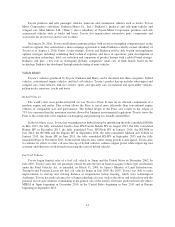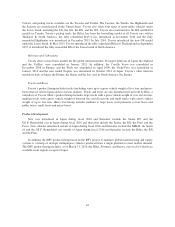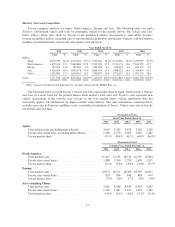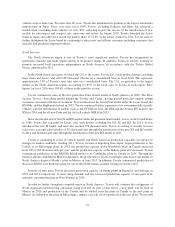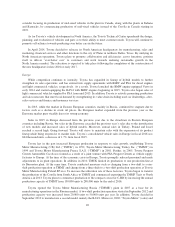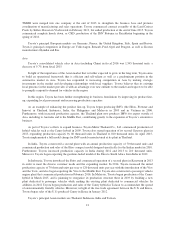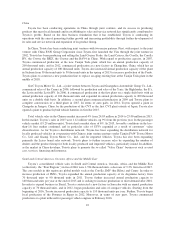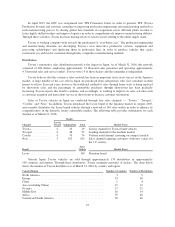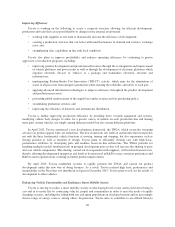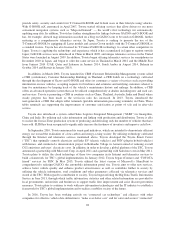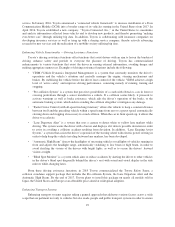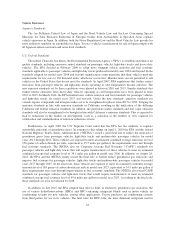Toyota 2015 Annual Report Download - page 29
Download and view the complete annual report
Please find page 29 of the 2015 Toyota annual report below. You can navigate through the pages in the report by either clicking on the pages listed below, or by using the keyword search tool below to find specific information within the annual report.The Toyota Production System
Toyota pioneered the internationally recognized production system known as the “Toyota Production
System.” The Toyota Production System is based on Toyota’s own concepts of efficient production of only
necessary and quality products and efficient cost reduction, and has the following two principal elements:
•“Just-in-Time,” and
•“Jidoka.”
Just-in-Time is an approach in which necessary parts and components are manufactured and delivered in just
the right quantity in a timely manner just as they are needed. This allows Toyota to maintain low levels of
inventory while maintaining operating efficiency.
Jidoka is a production concept which involves immediate stop of work when problems arise in the
production line in order to stop the production of defective items from being passed on to subsequent stages of
the process, and therefore making quality assurance an inherent part of the production process. To achieve this,
Toyota’s equipment is designed to detect and highlight abnormalities and to stop whenever abnormalities occur.
Toyota also authorizes its machine operators and other members of its production team to stop production
whenever they note anything suspicious. This helps Toyota to build quality into the production process by
avoiding defects and preventing the waste that would result from producing a series of defective items.
Toyota believes that the Toyota Production System allows it to achieve mass-production efficiencies even in
high-mix, low-volume production. This belief gives Toyota the flexibility to respond to changing consumer
demand without significantly increasing production costs. While the Toyota Production System remains the basis
of Toyota’s automobile production, the system has been expanded for use in Toyota’s parts production, logistics
and customer service activities as well.
Through the Toyota Production System, issues are identified and analyzed at the actual site, the entire
production process is made visible and production efficiency as well as product quality are improved through the
application of measures to address the sources of problems. As one method to implement these measures, Toyota
utilizes sophisticated information technologies to improve each step of its vehicle development process, from
product planning to commencement of mass-production. These technologies are intended to enhance flexibility,
simplification, quality, cost competitiveness and speed. Specifically, detailed virtual assembly and other
simulations of manufacturing processes are conducted on computers for a new vehicle or new production
equipment/systems before a prototype is made. An actual prototype is made only after defects and related issues
have been identified and resolved by computer simulation, thereby minimizing the time required for rebuilding
prototypes and significantly shortening the time required before starting mass production. Moreover, this system
is used to prepare virtual factories and other visual aids in order to facilitate training and communication at
overseas plants and enable the efficient transfer of necessary technology and skills.
In order to strengthen manufacturing and promote localization of overseas production, Toyota established
the Global Production Center (“GPC”) in July 2003 as a development and training center for global human
resources. The GPC is intended to introduce local managers to the Toyota methodology, allowing them to train
their subordinates while managing locally. GPC develops simple, easy-to-understand and efficient training
systems for the development of explicit knowledge. One characteristic of the GPC is that managers and
supervisors, new hires and experienced workers can all receive common skill-training. GPC’s training system
involves a pre-training phase where trainees learn basic skills and discover the skills that they must acquire
through image training. This is followed by various steps, from basic skill training and elemental task training to
standard task training, which ensures a step-by-step training. The fruits of this training method are reduced
training time, higher levels of achievement and the efficiency of training. Since January 2006, Toyota has opened
regional GPCs in North America, Europe and Asia. In each region, Toyota commenced courses where trainees
from each department are trained by local trainers to become trainers themselves.
24


